16 Sage Green Paint Colors for Serene Interiors
Imagine walking into a room that instantly calms and refreshes your senses—that’s the magic of sage green paint colors. Known for their soothing and versatile nature, these hues have become a favorite among design enthusiasts seeking a serene yet sophisticated vibe. Whether used as an accent or the main color, sage green effortlessly brings a touch of nature indoors, creating spaces that feel both peaceful and inviting.
In this article, you’ll find a curated selection of sage green shades that can transform your interiors. From soft, muted tones to richer, more vibrant greens, there’s a perfect hue for every style and mood. Get ready to discover inspiring ideas that will help you infuse tranquility and elegance into your home décor.
1. Soft Sage for a Calm Living Room Oasis
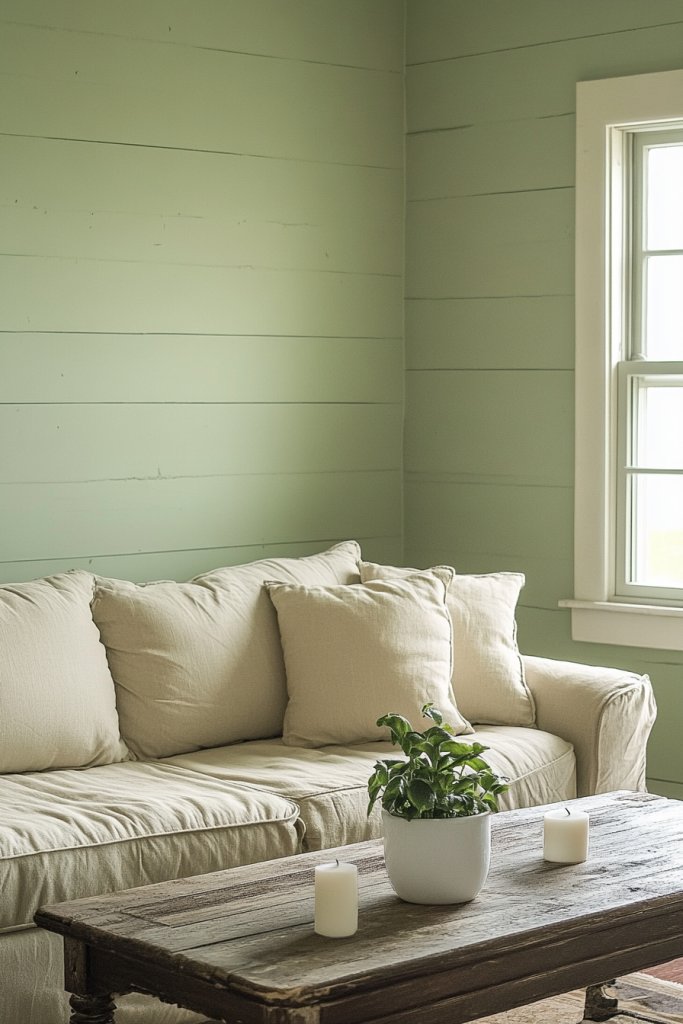
Ever feel like your living room is missing that peaceful vibe? Maybe it’s too cluttered, too loud, or just not inviting enough to unwind in after a long day. We all crave a space that instantly relaxes us, but achieving that calm can seem tricky. Finding the right paint color is often the first step toward creating a serene sanctuary.
Imagine sinking into a plush sofa covered with a soft cream throw blanket with chunky knit texture. The walls are painted in a muted sage that whispers tranquility, complemented by natural woven rugs and wooden accents. Soft daylight filters through sheer curtains, casting a gentle glow across the room. The overall feel is like a quiet forest retreat—peaceful and grounding.
This gentle sage works well with both warm and cool decor palettes. Pair it with beige or taupe furniture for a cozy vibe or contrast with crisp whites and navy accents for a more modern look. You can also adapt it seasonally by layering textiles—think warm throws in winter or lightweight linen cushions in summer. Small touches like textured cushions or soft curtains enhance the calming effect.
Start with a high-quality matte or eggshell finish in a soft sage hue—something like Benjamin Moore’s ‘Sage Mountain’ or Sherwin Williams’ ‘Comfort Gray.’ Prepare your walls by cleaning and lightly sanding for smooth application. Use painter’s tape to protect trim and moldings, and apply two coats for even coverage. Natural light will make the color glow, so consider the room’s sun exposure when choosing your shade. Finish with a low-sheen topcoat for durability.
Introduce layered textiles like a cozy wool rug, linen curtains, or a velvet armchair to add depth and tactile comfort. Incorporate metallic accents in fixtures or decorative hardware for subtle sophistication. Use textured wall hangings or woven baskets—avoiding wall art and greenery—to personalize without cluttering. Small DIY projects like painted wooden signs or carved wooden bowls can further reflect your style.
Opting for soft sage creates a timeless, calming backdrop that never goes out of style. It’s perfect for those who want a peaceful retreat without sacrificing style. Your guests will instantly notice the tranquil vibe, making your space a favorite spot to relax. With just a few simple changes, you can turn your living room into your personal serene sanctuary.
2. Deep Sage Accent Wall for Visual Depth
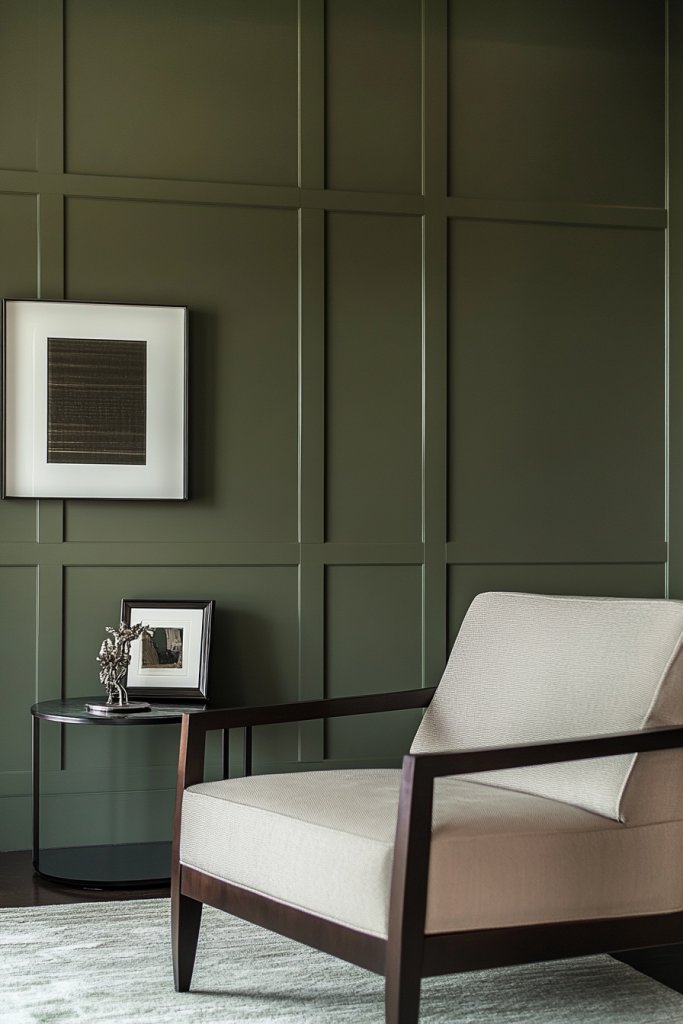
Ever wish your living space had more dimension without a total overhaul? An accent wall in a rich sage hue might be just what you need to add visual interest. It’s a simple trick that creates depth and draws the eye—perfect for making a small room feel larger or a plain wall pop.
Picture a wall painted in a deep, velvety sage, contrasted by light-colored, sleek furniture. The wall features minimalist decor—perhaps a sculptural mirror or a vintage-inspired shelf—highlighting the color. Ambient lighting casts soft shadows, emphasizing the richness of the paint. The room feels layered and sophisticated, with a focal point that invites curiosity.
This darker sage pairs beautifully with white, beige, or even charcoal accents. You could also layer textures like a textured wallpaper border or a faux plaster finish for added richness. For a more eclectic style, combine it with brass or black hardware. If space is limited, keep furniture light and airy to balance the bold wall.
Choose a high-quality, matte or low-sheen finish in a deep sage tone—think Sherwin Williams’ ‘Evergreen Fog’ or Benjamin Moore’s ‘Hallowed Hush.’ Prep your wall with cleaning and sanding, then tape off the area carefully. Use a roller for large sections and a brush for edges, applying two coats for full coverage. Consider using painter’s tape to create geometric patterns or stripes for added visual intrigue. Once dry, add decorative elements that complement the bold color.
Frame a statement piece of art or a vintage mirror on this accent wall—avoiding wall art and greenery—and let the color do the talking. Incorporate textured shelving or sculptural elements like concrete or ceramic decor to add tactile interest. You can also switch out accessories seasonally, like cozy throws or metallic objects, to keep the space fresh and engaging.
A deep sage accent wall instantly elevates your interior style, making it feel curated and intentional. It’s a bold choice that pays off by adding depth without overwhelming the space. When well executed, it turns a simple room into a stunning visual retreat—proof that one wall can transform the entire vibe.
3. Sage Green Kitchen Cabinets for Freshness
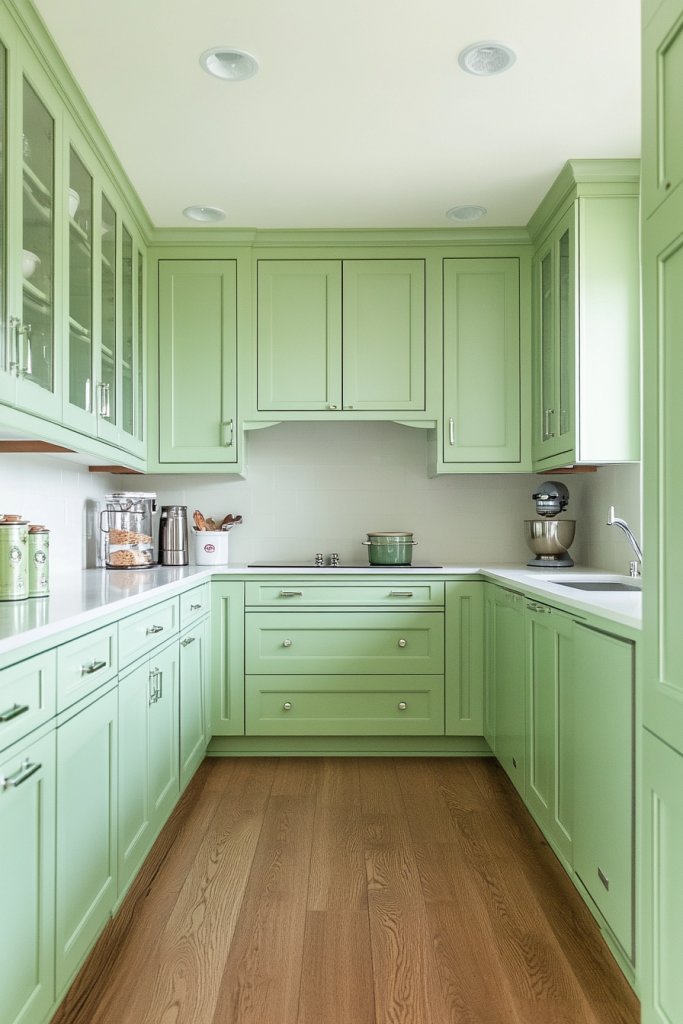
Tired of your dull, outdated kitchen? Perhaps it lacks the freshness and vibrancy you crave for cooking and entertaining. Painting your cabinets in a lively sage green can instantly uplift the space. It’s a bold move that combines nature-inspired color with modern style, transforming your kitchen into a cheerful hub.
Picture sleek sage-green cabinets paired with white quartz countertops and brushed brass hardware. The warm wood flooring complements the earthy tone, while a minimalist backsplash keeps the look clean. Under bright lighting, the sage hue feels lively yet calming—like a garden in full bloom. Open shelves with neatly arranged dishware add personality without cluttering.
Combine sage cabinets with white or gray walls for a crisp look, or go bold with a darker contrasting wall color. Add textured elements like a stone or tile backsplash to enhance the organic feel. Seasonal accents like a woven basket or a wooden cutting board can bring warmth, while maintaining a fresh aesthetic. If space allows, incorporate a kitchen island painted in a complementary hue for added visual interest.
Choose a durable, semi-gloss paint suitable for cabinetry, such as Benjamin Moore’s ‘Hollandale Green’ or Sherwin Williams’ ‘Sage Green Light.’ Remove cabinet doors and hardware, then sand surfaces lightly. Prime with a bonding primer for best adhesion, followed by two coats of your chosen paint. Use a high-quality brush or sprayer for smooth coverage. Reinstall hardware and add coordinating accessories—like metallic drawer pulls or a textured rug—to complete the look. Ensure good ventilation during painting.
Introduce open shelving to display colorful dishware or vintage ceramics that contrast with the sage. Add a touch of greenery through decorative faux plants—avoiding real plants if restricted—or opt for sculptural, ceramic planters. Incorporate textured textiles like a woven runner or fabric-lined baskets for storage. Personalize with unique hardware or custom-painted signs that reflect your style.
Sage kitchen cabinets strike a perfect balance between fresh and timeless, making your space feel alive and inviting. They work well with various decor styles, from farmhouse to modern minimalism. With this color, your kitchen becomes a lively, cheerful spot that encourages culinary creativity and social gatherings—proof that paint can truly change everything.
4. Elegant Sage Bedroom Walls for Restful Sleep
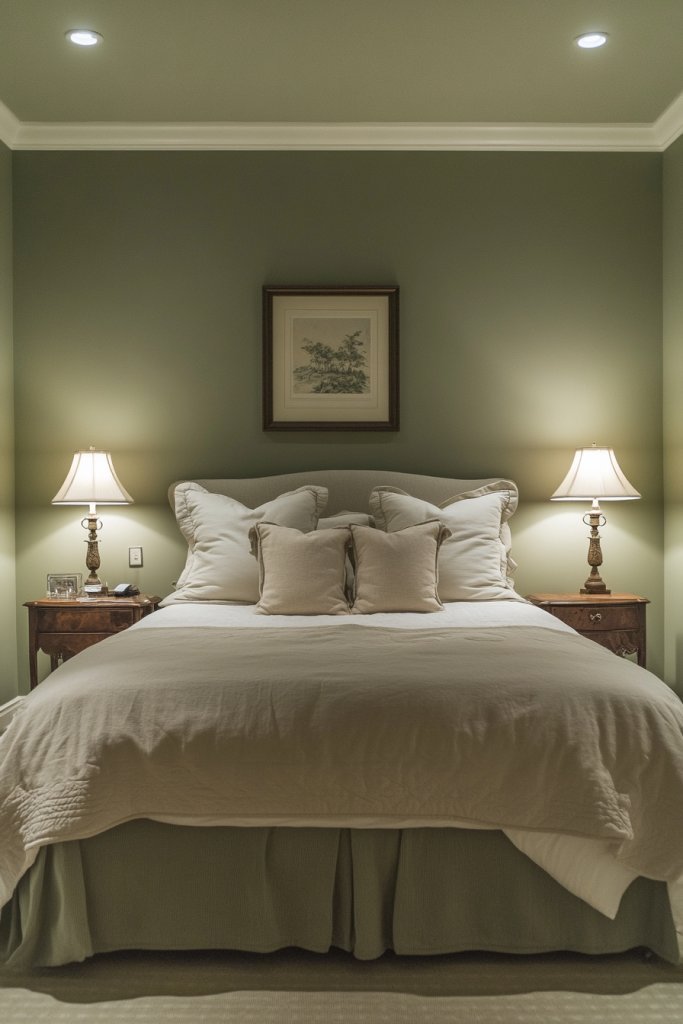
Does your bedroom lack that peaceful, sleep-inducing vibe? Maybe the colors are too stimulating, or the space feels chaotic. Creating an elegant, calming environment is key to restful nights. Painting your bedroom walls in a soothing sage hue can help you unwind and drift off more easily.
Imagine drifting into bed under a soft duvet in neutral tones, with walls bathed in a gentle sage that reflects the early morning light. Layered bedding in whites, creams, or muted pastels adds to the serenity. A plush, textured headboard and cozy throw pillows complete the inviting retreat. The overall ambiance feels like a peaceful forest glade—calm and restorative.
Pair sage walls with soft, neutral textiles for a minimalist look, or add warm metallic accents for a touch of luxury. Incorporate a variety of textures—think velvet cushions, linen sheets, or a shaggy rug—to create a layered, cozy feel. For different seasons, swap out bedding and accessories to keep the room feeling fresh and inviting—warm in winter, airy in summer.
Select a calming sage shade like Benjamin Moore’s ‘Sage Mist’ or Sherwin Williams’ ‘Sea Salt.’ Prep walls by cleaning and lightly sanding, then apply a high-quality matte or eggshell finish—these finishes reduce glare and promote relaxation. Use painter’s tape to protect trim, and apply two coats with proper drying time. Keep lighting soft with warm bulbs or dimmable fixtures for ultimate sleep comfort. Keep decor minimal—avoid wall art and greenery—and focus on plush textiles.
Introduce personal touches with textured throws, layered blankets, or decorative pillows in complementary shades. Incorporate a custom headboard or textured wallpaper behind the bed for added interest. Use scented candles or diffusers to enhance the calming atmosphere—just avoid clutter or overly bright accessories. Subtle, textured wall hangings or fabric panels can add warmth without disrupting the serenity.
A sage bedroom is a timeless choice that promotes sleep and relaxation. It’s adaptable to various decor styles and personal tastes, making it easy to maintain a peaceful environment. When your bedroom feels like a retreat, every night becomes an opportunity for restful, rejuvenating sleep—proof that color can truly transform your lifestyle.
5. Sage Green Trim and Molding for Subtle Sophistication
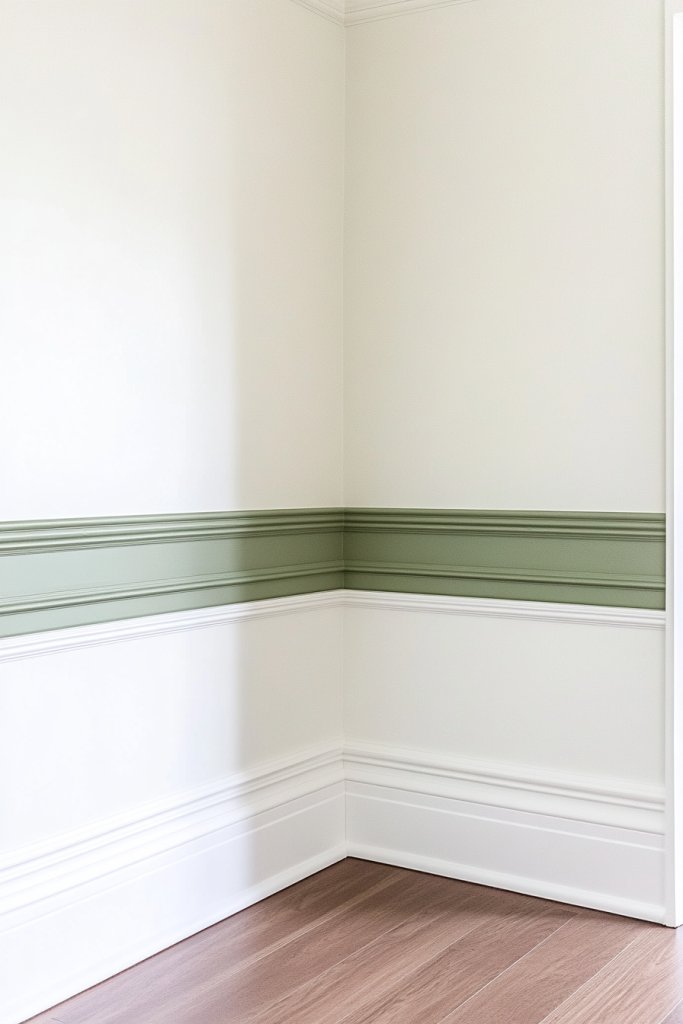
Sometimes, the smallest detail can make the biggest difference in a room. Do plain white trims and moldings leave your space feeling flat? Adding a subtle touch of sage green to these areas can elevate your decor with minimal effort. It’s a clever way to introduce color and sophistication without overwhelming the space.
Picture crisp white walls contrasted with sage-green trim outlining door frames, baseboards, and crown molding. The color adds depth and a refined touch while keeping the overall look understated. Soft light reflects off the painted moldings, highlighting their crisp edges. This subtle detail creates a layered, polished aesthetic that feels both classic and modern.
Choose a muted, matte sage for a subtle effect or a satin finish for a slight sheen that catches the light. This technique works well in both traditional and contemporary interiors. For a cohesive look, paint window casings and door frames in the same hue. Seasonal tweaks include adding decorative trims or faux wood finishes for textured variation.
Select a high-quality paint in a sage tone like Sherwin Williams’ ‘Sage’ or Benjamin Moore’s ‘Sage Mountain.’ Carefully tape off edges to ensure clean lines and prevent bleed. Use a small, angled brush for precision around corners and intricate moldings. Apply two coats, waiting for each to dry thoroughly. For a more durable finish, consider semi-gloss or satin paint designed for trim. Reinstall hardware and touch up as needed.
Add decorative corner blocks or ornate trim moldings in the same color for a vintage touch. Use contrasting paint in a darker shade for inner grooves or detailing to create visual interest. Keep the look simple and elegant by avoiding overly ornate designs—let the color do the work. Small decorative elements like vintage door knobs or subtle hardware can enhance the overall sophistication.
Painting trim and moldings in sage adds a layer of refined elegance that elevates any room. It’s a subtle upgrade with a big impact, perfect for a designer look on a budget. When done right, it creates a seamless flow between architectural details and wall colors—making your space feel cohesive and thoughtfully curated. Small details like these truly make your home stand out.
6. Light Sage Hallway for Bright, Inviting Passage

Hallways often get overlooked but are key to making your home feel welcoming. If your corridor feels dark or uninviting, a splash of light sage paint can brighten it up instantly. Brightening narrow passageways creates a more open, airy feel while adding a touch of subtle color.
Visualize a slender hallway painted in a soft, pale sage that reflects natural light beautifully. A slender console table with decorative accents or a sleek mirror can add personality without crowding the space. The walls glow softly, and the light color makes the hallway seem wider and more inviting. Small framed photos or decorative wall decals subtly personalize the space.
Choose a very light, almost pastel sage for a fresh, airy feel. For added depth, consider a slightly darker hue on one accent wall or using textured wall paint techniques. Seasonal updates could include hanging lightweight fabrics or adding a runner rug in complementary shades. For larger hallways, incorporating vertical storage or slim shelving can maximize utility without clutter.
Pick a high-quality, light sage paint like Sherwin Williams’ ‘Sea Salt’ or Benjamin Moore’s ‘Sage Mist.’ Prepare the surface by cleaning and sanding, then tape off edges carefully. Use a roller to cover large areas evenly, and a brush for corners. Apply two coats, allowing proper drying time. Enhance the space with wall-mounted hooks or slim shelves—avoiding artwork and greenery—and keep lighting soft with wall sconces or LED strips.
Decorate with a narrow, textured runner to add warmth and pattern. Use decorative hooks or slim shelving to display personal items like keys or small decorative objects—avoiding plants or artwork. Incorporate a small, sculptural element like a ceramic sculpture or a textured wall panel for visual interest. Keep accessories simple and functional, emphasizing the color’s brightness.
A light sage hallway transforms a usually overlooked area into a bright, welcoming passage. It’s a simple upgrade that makes the entire home feel more spacious and cohesive. With a clean, fresh look, you’ll enjoy walking through your home more—and impress guests with your thoughtful design choices.
7. Sage Green Nursery for a Restful Baby Space
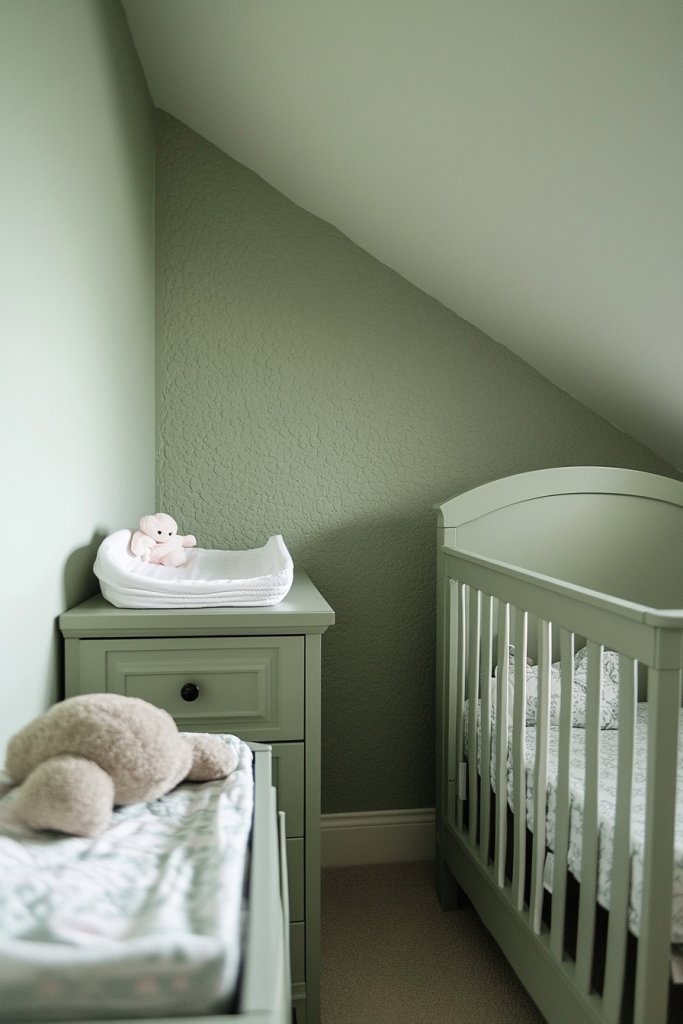
Designing a nursery that feels calm and soothing can be tricky, especially with all the bright, busy options out there. Parents want a space that promotes relaxation for both baby and caregiver. A gentle sage green painted on the walls creates a peaceful environment that’s perfect for nap times and bedtime.
Imagine a nursery with walls painted in a soft, dusty sage that reflects gentle morning light. White or light wood furniture keeps the space airy, while plush textiles like a cozy rug and padded crib bedding add tactile comfort. Subtle decorative elements, such as textured blankets and soft cushions, make the room inviting without overstimulation. The overall effect is a tranquil haven for your little one.
Pair sage walls with pastel or neutral textiles, such as blush pink or light gray, for a versatile look. Incorporate textured wall panels or subtle wallpaper borders to add visual interest without clutter. Seasonal changes might include swapping out bedding or adding plush textiles in different shades to keep the atmosphere calm and engaging. Use functional storage solutions that blend seamlessly with the color palette.
Pick a soft, muted sage like Sherwin Williams’ ‘Sea Salt’ or Benjamin Moore’s ‘Sage Mist.’ Prepare the surface by cleaning and lightly sanding. Use a matte or eggshell finish for a gentle, non-reflective surface that promotes sleep. Apply two coats with even strokes, and allow plenty of drying time. Opt for low-VOC or eco-friendly paints to ensure the space remains healthy. Decorate minimally with soft textiles, avoiding wall art and greenery—as per restrictions—and focus on tactile comfort.
Add textured textiles like a soft rug, plush cushions, or a breathable canopy for a cozy feel. Incorporate personalized textiles with embroidered initials or subtle patterns. Use decorative storage bins in neutral tones to keep the room tidy. Small, sculptural decor items—like a wooden mobile or fabric-wrapped elements—can add visual interest without violating restrictions.
A sage nursery offers a peaceful retreat that grows with your child, providing a calming space for years to come. Its timeless, soothing hue makes it easy to update with accessories as your little one grows. Creating a tranquil environment helps everyone rest better and enjoy moments of calm amidst busy days—proof that thoughtful color choices truly make a difference.
8. Sage and Neutrals in a Scandinavian-Style Living Room
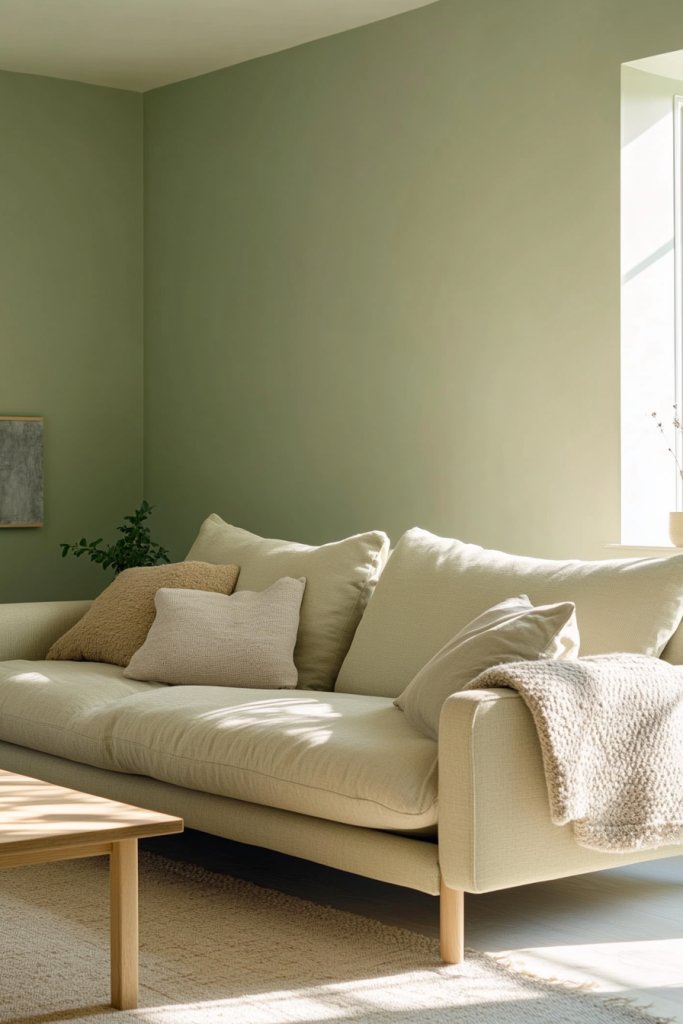
Want a living room that feels both modern and cozy without feeling cluttered? Scandinavian design emphasizes simplicity, functionality, and calm. Incorporating sage green with neutral shades creates a balanced, inviting space that’s perfect for relaxing or entertaining. It’s the ideal palette for minimalist lovers who still crave warmth.
Visualize a bright living room with sage green walls paired with white or beige furniture. Light wood accents and woven textiles add warmth and texture, while black or dark metal fixtures provide contrast. Candles or simple decorative objects in muted tones enhance the serene vibe. Natural light floods the space, emphasizing the harmonious blend of colors and materials. The overall look is airy, calm, and effortlessly stylish.
Combine sage with shades of white, cream, or soft gray for a monochromatic, layered look. Incorporate textured fabrics like wool throws or linen cushions for tactile warmth. For a seasonal refresh, swap textiles or add cozy accessories like faux fur throws—avoiding wall art and greenery—and emphasize architectural details and furniture as focal points.
Choose a matte or eggshell finish in a sage tone similar to Benjamin Moore’s ‘Sage Mountain’ or Sherwin Williams’ ‘Sea Salt.’ Prepare walls by cleaning and lightly sanding, then apply two coats of paint for even coverage. Use simple, clean-lined furniture—think Scandinavian-inspired sofas and tables—and keep clutter to a minimum. Use natural fiber rugs and woven baskets for storage, emphasizing functionality. Lighting should be soft, with options like sconces or floor lamps that blend into the decor.
Layer textiles with different textures—think knit or faux fur—to add visual interest. Incorporate sculptural objects or geometric ceramics instead of wall art. Use decorative baskets or storage cubes that blend seamlessly with the color palette. Small details like a minimalist clock or a textured cushion can personalize the space without cluttering it.
A sage and neutral palette rooted in Scandinavian style creates a space that’s timeless and adaptable. It’s a blank canvas that invites creativity while maintaining calm. This approach proves that less truly is more—your living room can be both beautiful and functional, reflecting a modern, peaceful lifestyle.
9. Rich Sage in a Formal Dining Area for Elegance

Hosting dinner parties or family meals in a dull space can kill the mood. You want your dining area to feel sophisticated yet welcoming. A rich sage hue on the walls can add a layer of elegance and depth, making every meal feel special. It’s a subtle way to elevate your space without going overboard.
Imagine a formal dining room with walls painted in a deep, luxurious sage that creates a warm, intimate atmosphere. Gold or brass accents in lighting fixtures or tableware reflect the hue’s richness. A large wooden table with upholstered chairs anchors the space, while a textured rug or a decorative sideboard enhances the ambiance. Soft lighting casts a warm glow, making the setting feel both refined and inviting.
Pair a dark sage with rich jewel tones like emerald or sapphire for a luxurious vibe. Incorporate metallic accents in light fixtures or decorative accessories to amplify the elegance. For a more classic style, add ornate moldings or vintage-inspired furniture. Seasonal updates can include plush table runners or velvet curtains, avoiding wall art and greenery, to keep the focus on the sophisticated palette.
Select a deep, high-quality matte or satin finish—such as Sherwin Williams’ ‘Evergreen Fog’ or Benjamin Moore’s ‘Hallowed Hush.’ Prepare walls by cleaning and sanding lightly. Use painter’s tape for precise edges and apply two coats, allowing sufficient drying time. Incorporate elegant lighting—think chandeliers or sconces—that complements the mood. Coordinate table settings and accessories in metallics and rich fabrics to complete the look, focusing on the paint’s depth.
Add personal touches with textured fabric table runners, velvet cushions, or embroidered napkins—avoiding wall art and greenery. Use decorative metallic objects or sculptural centerpieces to enhance the sophistication. Incorporate vintage or ornate furniture pieces for a regal feel. Small accents like candle holders or art deco elements can elevate the space further.
A rich sage dining area exudes elegance and invites memorable gatherings. Its timeless appeal makes it suitable for both modern and traditional interiors. When crafted with attention to detail, it transforms everyday meals into special occasions—showing how color and decor can redefine your lifestyle.
10. Sage Green Paint with Textured Wall Techniques

Flat, boring walls can make even the most stylish room feel dull. If you want to add visual interest without clutter or artwork, textured wall techniques in sage green offer a creative solution. They bring depth and tactile appeal, elevating your decor with subtle artistry. It’s a fun way to craft a unique backdrop that’s both stylish and sophisticated.
Picture a wall with a faux plaster finish in a muted sage, adding a sense of history and craftsmanship. The texture catches light at different angles, creating shadows that shift throughout the day. Complement it with simple furniture and minimal decor, allowing the wall’s texture to shine. The overall vibe is warm and inviting, with a handcrafted feel.
Use techniques like stippling, sponging, or troweled plaster to create varied textures—each adding its own character. Pair textured walls with smooth, matte finishes elsewhere for contrast. Incorporate textured textiles and layered fabrics to complement the tactile aspect, avoiding artwork and greenery. Seasonal accents like woven baskets or textured throws enhance the cozy aesthetic.
Start with a high-quality sage paint suitable for textured finishes—Sherwin Williams’ ‘Faux Effects’ or custom mixes. Prepare walls by cleaning thoroughly, filling holes, and sanding rough spots. Use sponges, brushes, or trowels to create the desired texture—practice on a small area first. Apply the textured paint in sections, working quickly to maintain consistency. Finish with a protective sealant if desired, and add simple decor that highlights the textured surface.
Incorporate textured wall panels or sculptural plaster accents for added interest. Use textiles like woven throws or textured cushions that echo the wall’s tactile qualities. Small, sculptural decor pieces or vintage finds can further personalize the space. Keep accessories minimal to let the wall’s texture be the star, and avoid cluttering with art or greenery.
Textured sage walls create a unique, handcrafted look that instantly elevates your interior. It’s a subtle statement of artistry and personality. When done well, textured walls become a conversation piece and a signature element of your home—proof that texture and color can work together beautifully.
11. Sage Green for Vintage-Inspired Interiors
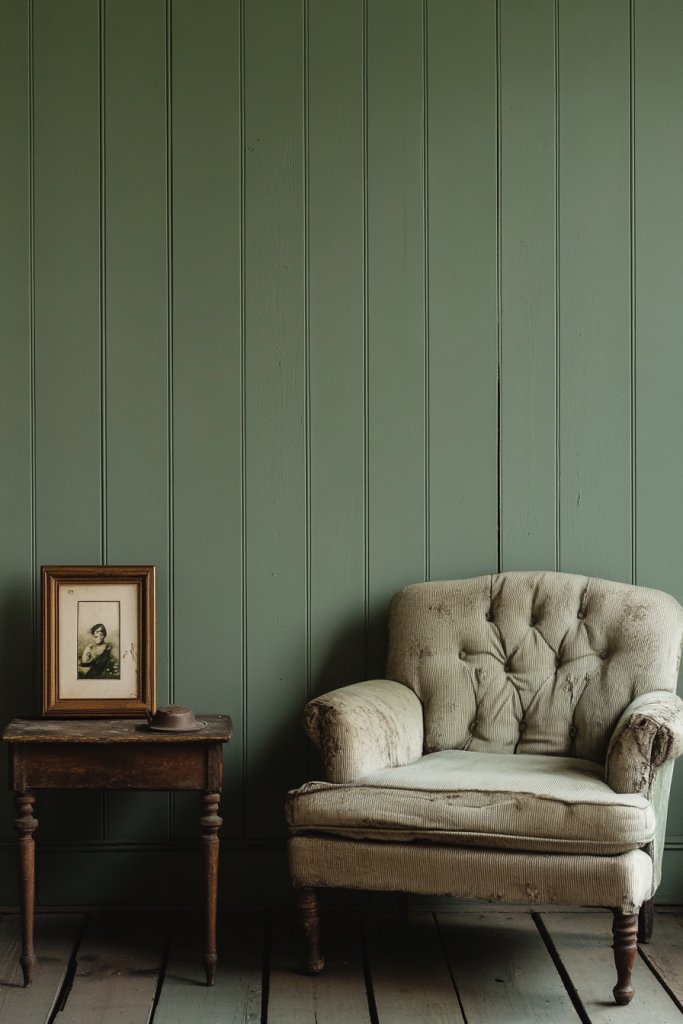
Dreaming of a space that feels nostalgic yet timeless? Vintage-inspired interiors evoke charm and character, but finding the right color palette can be tricky. Sage green, with its muted, dusty tone, perfectly captures that vintage vibe. It’s a versatile hue that pairs beautifully with antique furniture and classic accessories.
Imagine a cozy living room with a vintage armchair in soft sage, paired with a distressed wooden side table and a plush, textured rug. The walls are painted in a muted sage that complements antique frames, old books, and ceramic accessories. Soft lighting and nostalgic textiles complete the look, creating a space that feels both warm and inviting—like stepping into a bygone era.
Combine sage with warm neutrals like caramel, blush, or cream for a truly nostalgic feel. Incorporate vintage furniture pieces with ornate details or distressed finishes. Use classic patterns like floral or damask in textiles, avoiding modern art or sleek minimalism. Seasonal updates might include adding vintage-inspired textiles or decorative objects that tell a story.
Pick a muted, dusty sage shade like Benjamin Moore’s ‘Sage Mountain’ or Sherwin Williams’ ‘Faintest Sage.’ Prepare walls by cleaning and sanding, then apply two coats of matte or eggshell finish. Incorporate vintage furniture with distressed paint or patina finishes. Use decorative ceramics, old picture frames, and nostalgic textiles to build authenticity—avoiding artwork and greenery. Focus on creating a layered, story-rich environment.
Decorate with antique vases, vintage textiles, or retro lamps—avoiding typical wall art and plants. Use ornate picture frames or vintage mirrors to add charm. Incorporate nostalgic accessories like old clocks or vintage books for a curated feel. Small DIY projects like restoring furniture or creating custom ceramic pieces can personalize the space further.
A vintage-inspired sage interior feels cozy, timeless, and full of character. It reminds us that history and style can blend seamlessly, creating a space that’s both nostalgic and fresh. When you infuse your home with personal stories and well-chosen pieces, you build a unique environment that stands out—and feels like home.
12. Sage Green in a Home Office for Focus and Calm
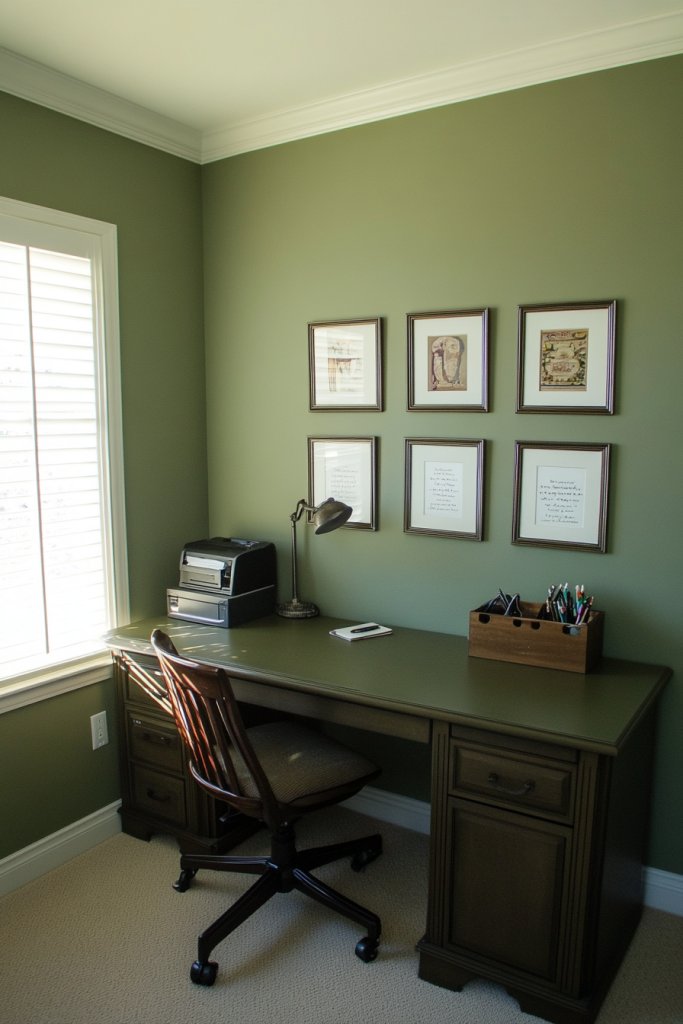
Struggling to concentrate in a cluttered or chaotic workspace? A calming environment can boost productivity and reduce stress. Painting your home office in a soothing sage green creates a tranquil setting that helps you focus. It’s a subtle way to make your workspace more inviting and less overwhelming.
Imagine a clean, organized desk with sage-colored walls serving as a peaceful backdrop. Natural light filters in, highlighting a simple, functional setup—think open shelving, a comfortable chair, and minimal decor. Soft textiles like a woven desk mat or a subtle curtain in neutral shades add tactile warmth. The overall effect is a balanced space that promotes clarity and calm.
Pair sage with white or beige furniture for a fresh look, or add darker accents like charcoal or black for contrast. Incorporate textured textiles such as a woven rug or a fabric-covered bulletin board—avoiding wall art and greenery—to create visual interest. Seasonal updates could include swapping out textiles or adding small decorative objects in calming shades.
Choose a soft sage like Sherwin Williams’ ‘Sea Salt’ or Benjamin Moore’s ‘Sage Mist.’ Prepare walls by cleaning and lightly sanding, then apply two coats of matte or eggshell finish for a non-reflective surface. Use a roller for large areas and a brush for edges. Keep your furniture simple and ergonomic, with clean lines. Incorporate organizational accessories—like storage boxes and desktop organizers—that match the color palette. Proper lighting, such as daylight bulbs or soft LED strips, enhances focus.
Use textured textiles like woven baskets or soft fabric-covered pinboards to add tactile interest. Personalize with functional decor—like a geometric desk lamp or a sculptural paperweight—avoiding wall art and plants. Incorporate small, neat storage solutions to keep clutter at bay. Choose accessories that reflect your style, such as minimalist sculptures or sleek organizers.
A sage green home office promotes focus and tranquility, making work feel less stressful. It’s a simple change that can boost your productivity and mental clarity. When your workspace feels calming and organized, it’s easier to stay motivated and inspired every day—proof that color impacts mindset.
13. Monochromatic Sage Palette for Cohesive Spaces
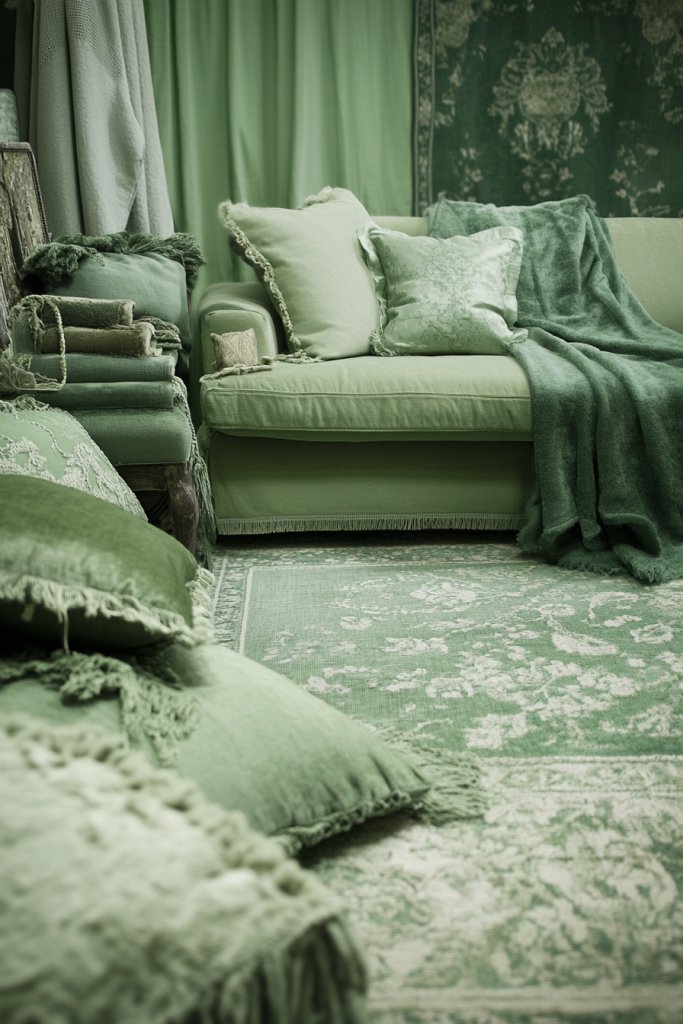
Feeling overwhelmed by mismatched decor and conflicting colors? A monochromatic sage palette offers a sleek solution for creating a harmonious, seamless space. Layering different shades of sage across walls, furniture, and textiles produces a calming, uniform look. It’s a modern twist on traditional color schemes that feels both peaceful and sophisticated.
Visualize a room where walls, curtains, and cushions all share varying shades of sage—light, mid-tone, and dark—blending effortlessly. The furniture features clean lines, with some pieces painted in matching or slightly contrasting hues. Textured textiles, like a woven throw or a velvet cushion, add depth without breaking the color harmony. Soft, natural light enhances the layered shades, creating a cohesive, tranquil environment.
Mix matte and satin finishes in different shades to add subtle variation. Introduce textured fabrics like boucle or velvet for tactile interest, while avoiding wall art and greenery. For seasonal updates, swap out textiles or add cozy throws and cushions in coordinating hues. Keep accessories minimal to maintain the seamless, unified look.
Select a range of sage shades from brands like Sherwin Williams or Benjamin Moore—think ‘Sage’, ‘Faintest Sage’, and ‘Hallowed Hush.’ Prepare surfaces by cleaning and sanding, then paint with a brush or roller, applying two coats for consistency. Use painter’s tape to create clean edges and avoid mismatched lines. Incorporate textured textiles in similar shades, such as wool or velvet, and layer them for visual interest. Keep lighting soft and natural, avoiding any overly bright or contrasting fixtures.
Add textured textiles like a boucle rug, velvet cushions, or woven throws to deepen the monochrome effect. Incorporate sculptural elements or geometric ceramics in similar shades for visual interest—avoiding artwork and greenery. Use decorative storage baskets or fabric bins for organization. Small personal touches like a custom-made cushion or a textured lamp can make the space uniquely yours.
A monochromatic sage palette creates a serene, cohesive environment that’s easy to update and maintain. It fosters a sense of calm and order, making the space feel intentional and stylish. When layered thoughtfully, this approach proves that simplicity and harmony can elevate your entire home—your personal sanctuary of peace.
14. Sage Green with Metallic Accents for Modern Chic
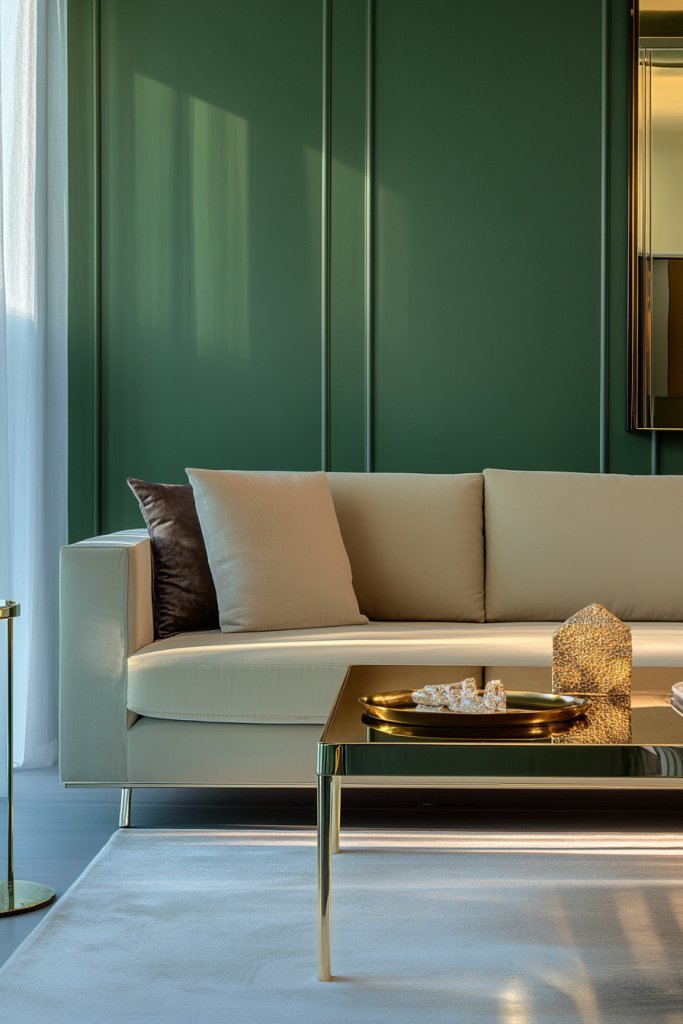
Looking to add a touch of glamour to your space without going overboard? Metallic accents combined with sage green create a perfect balance of modern elegance and subtle luxury. It’s an effortless way to upgrade your decor and make any room feel more refined and stylish. Who says you can’t have a little glitz in a calm palette?
Visualize a living room with sage green walls paired with copper or gold fixtures—think light fixtures, hardware, or decorative objects. A plush velvet sofa in neutral tones sits against the backdrop, while metallic side tables or decorative bowls add shimmer. Soft lighting highlights the warm undertones of the metallic accents, creating a cozy yet sophisticated atmosphere. The overall vibe is chic, inviting, and effortlessly elegant.
Combine sage with warm metallics like brass or copper for a cozy feel, or opt for silver or chrome for a cooler, contemporary look. Use textured fabrics like velvet or silk cushions to add richness. Incorporate metallic decorative objects—such as sculptures or picture frames—and keep the rest of the decor minimal. Seasonal updates include swapping out textiles or adding metallic accessories to refresh the look.
Choose a matte or eggshell sage paint—such as Sherwin Williams’ ‘Sage’ or Benjamin Moore’s ‘Sage Mountain.’ Prepare walls by cleaning and lightly sanding, then apply two coats for even coverage. Select fixtures and decor in metallic finishes—think brushed brass, matte copper, or polished chrome. Incorporate metallic accessories like picture frames, vases, or sculptures, avoiding wall art and greenery. Use warm lighting to enhance the metallic glow—think sconces or table lamps with metallic accents.
Add textured textiles like velvet cushions, silk curtains, or metallic accent pillows to deepen the luxe feel. Incorporate sculptural objects or geometric ceramics in matching metallic hues—avoiding artwork and plants—to create visual interest. Personalize with unique metallic decor pieces, like a statement chandelier or a decorative tray. Small touches like metallic photo frames or candle holders elevate the overall aesthetic.
Pairing sage green with metallic accents crafts a modern chic space that feels both fresh and timeless. It demonstrates that subtle touches of glamour can elevate everyday decor. When executed thoughtfully, this look creates an environment that’s stylish and inviting—showing how simple elements can have a big impact on your home’s vibe.
15. Minimalist Sage Bedrooms with Natural Materials

Is your bedroom feeling more cluttered than calming? Struggling to find a peaceful retreat amid busy decor? Embracing minimalist design with sage walls and natural materials can help you create a tranquil sanctuary. It’s about stripping away excess and focusing on what truly matters—rest and relaxation.
Picture a spacious bedroom with soft sage walls paired with a simple wooden bed frame and neutral bedding. A textured wool or linen duvet adds tactile warmth, while a low-profile wooden bench or side table completes the look. The space is free of clutter, with hidden storage and a few carefully chosen decorative elements—like a woven basket or a simple ceramic lamp—adding texture without distraction. The overall effect is calm, clean, and inviting.
Combine sage with natural fibers like jute, linen, or wool for textiles, and wooden or bamboo furniture for a warm, organic feel. Keep decor to a minimum—think a single sculptural object or a textured throw—avoiding wall art and greenery. Seasonal updates can include swapping textiles or adding a simple, textured rug for warmth. Focus on high-quality, durable pieces that age gracefully.
Select a soothing sage color such as Benjamin Moore’s ‘Sage Mist’ or Sherwin Williams’ ‘Sea Salt.’ Prepare walls by cleaning and lightly sanding, then apply two coats of matte or eggshell finish—ideal for a non-reflective, peaceful surface. Use natural, unpainted wood furniture—like a platform bed or a nightstand—and keep surfaces clear. Incorporate natural textiles, such as linen sheets or wool blankets, for a tactile layer. Keep lighting soft with warm LED bulbs or indirect lighting to enhance the restful mood.
Add textured textiles like woven throws or wool rugs to deepen the tactile experience. Use sculptural wooden or ceramic decor to add visual interest, avoiding wall art or artificial plants. Incorporate personal touches like a handmade quilt or a vintage clock—subtle and meaningful. Focus on creating a clutter-free, serene environment that invites restful sleep.
A minimalist sage bedroom offers a timeless, calming retreat that adapts to any style. It’s a space designed for peace and rejuvenation, proving that less truly is more. When your surroundings reflect tranquility, your overall well-being benefits—making your home a true sanctuary of calm.
16. Sage Green Paint as a Backdrop for Art and Decor
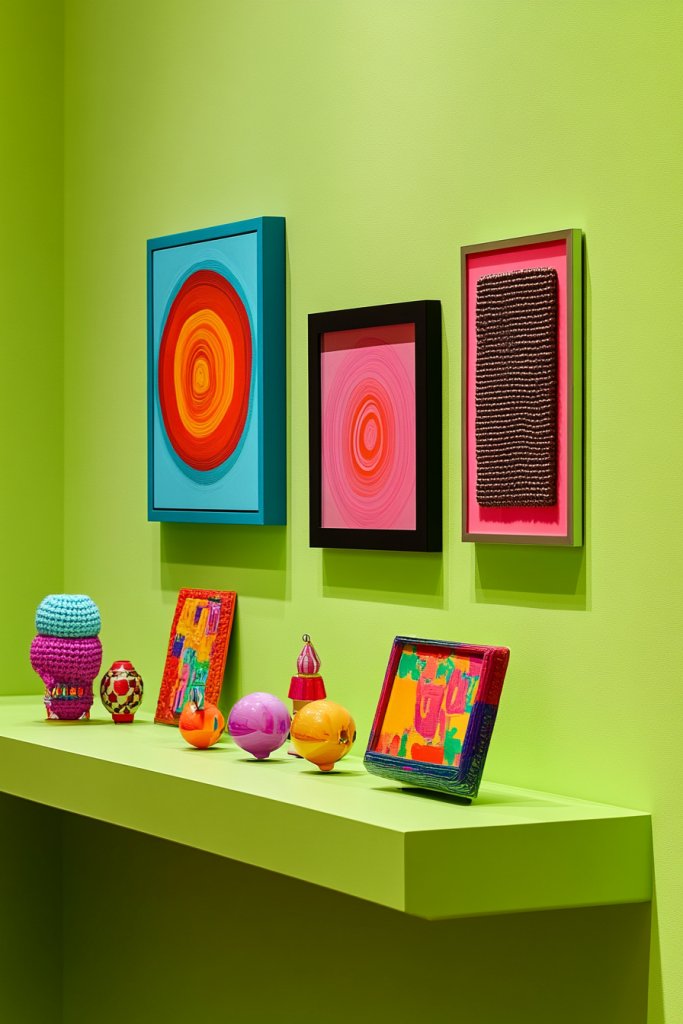
Tired of your walls competing with your decor? Want a neutral yet stylish backdrop that highlights your art and accessories? Sage green provides the perfect canvas—subtle enough to let colorful or textured pieces shine without overpowering. It’s an elegant way to create balance and harmony in your space.
Imagine a living room or hallway with sage-painted walls that serve as a calming background. Bright, bold artwork or textured sculptures stand out beautifully against the muted green. The space feels both lively and cohesive, with the sage hue tying everything together. Light-colored furniture and simple textiles keep the focus on your art, creating an inspiring environment.
Use a softer sage for a subtle background or a darker shade for a more dramatic effect. Keep furniture and textiles neutral—whites, creams, or beiges—to avoid competing with your art. Incorporate textured wall panels or sculptural decor to add visual interest, avoiding wall art and greenery. Seasonal updates might include swapping out textiles or adding new art pieces that complement the base color.
Choose a versatile sage hue like Sherwin Williams’ ‘Sea Salt’ or Benjamin Moore’s ‘Sage Mountain.’ Prepare walls by cleaning and sanding, then apply two coats of matte or eggshell finish for a smooth, non-reflective surface. Use simple, sleek frames or display shelves to showcase artwork. Keep lighting soft and adjustable—think dimmable LEDs or wall sconces—to highlight your pieces. Avoid clutter, and focus on creating a balanced, gallery-like atmosphere.
Showcase pieces that evoke your personality—colorful paintings, textured textiles, or sculptural objects—while avoiding wall art and plants. Incorporate subtle metallic or ceramic decor to add richness. Rotate artworks seasonally to refresh the space, and add textured pillows or throws for tactile variation. Personal touches like custom framing or DIY art make your display uniquely yours.
Using sage as a backdrop elevates your art collection and decor, making your home feel curated and intentional. It’s a versatile choice that adapts to changing styles or collections. When your walls serve as a subtle stage for your favorite pieces, your space becomes more inspiring—proof that thoughtful color choices empower your personal style.
Conclusion
Exploring these diverse sage green paint colors reveals countless ways to craft tranquil and stylish interiors. Whether you choose subtle shades or bold tones, these colors can elevate any space with their calming presence. Don’t hesitate to try out different hues and see how they transform your home into a peaceful retreat—your ideal serene sanctuary is just a paint choice away!
